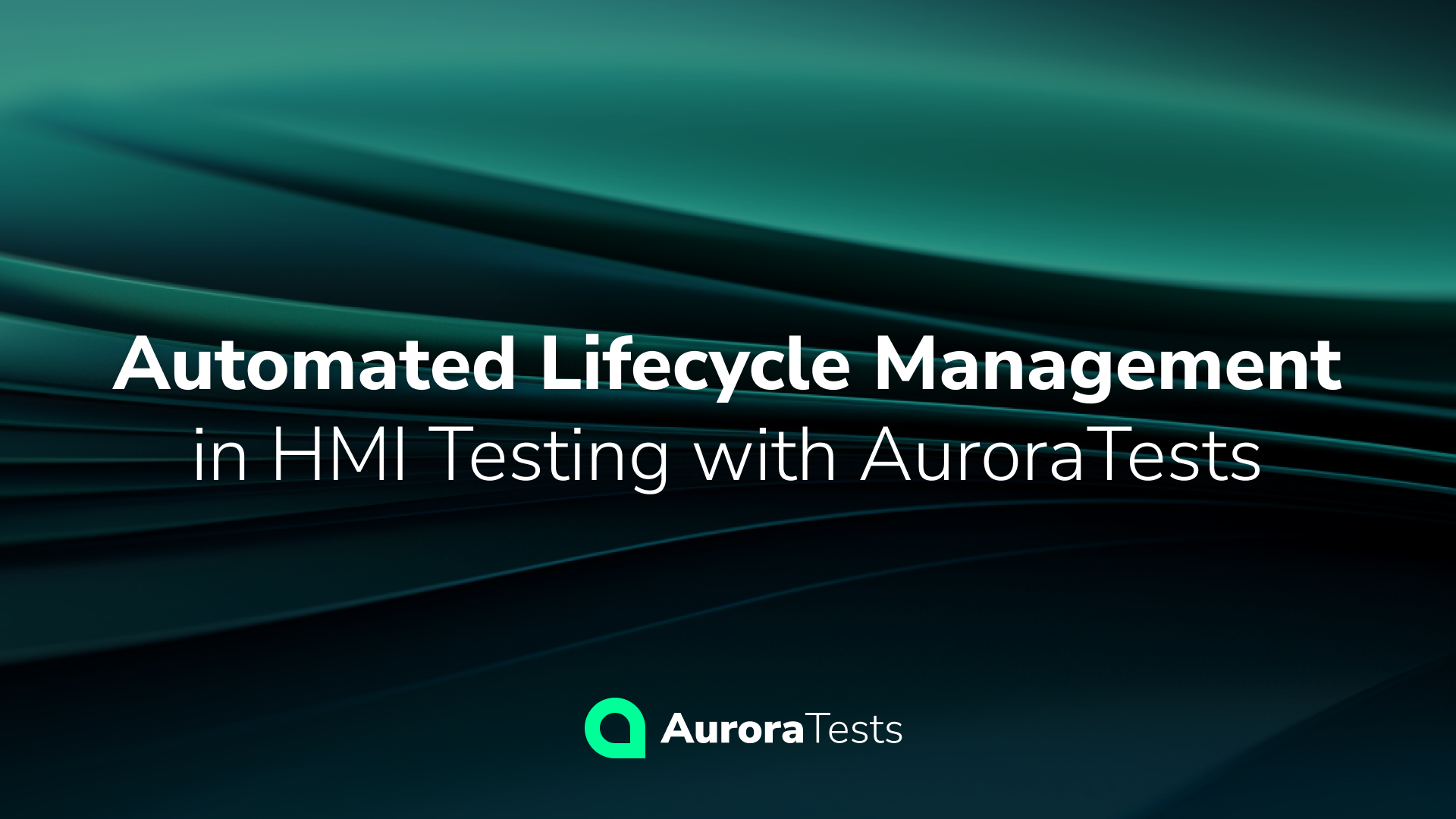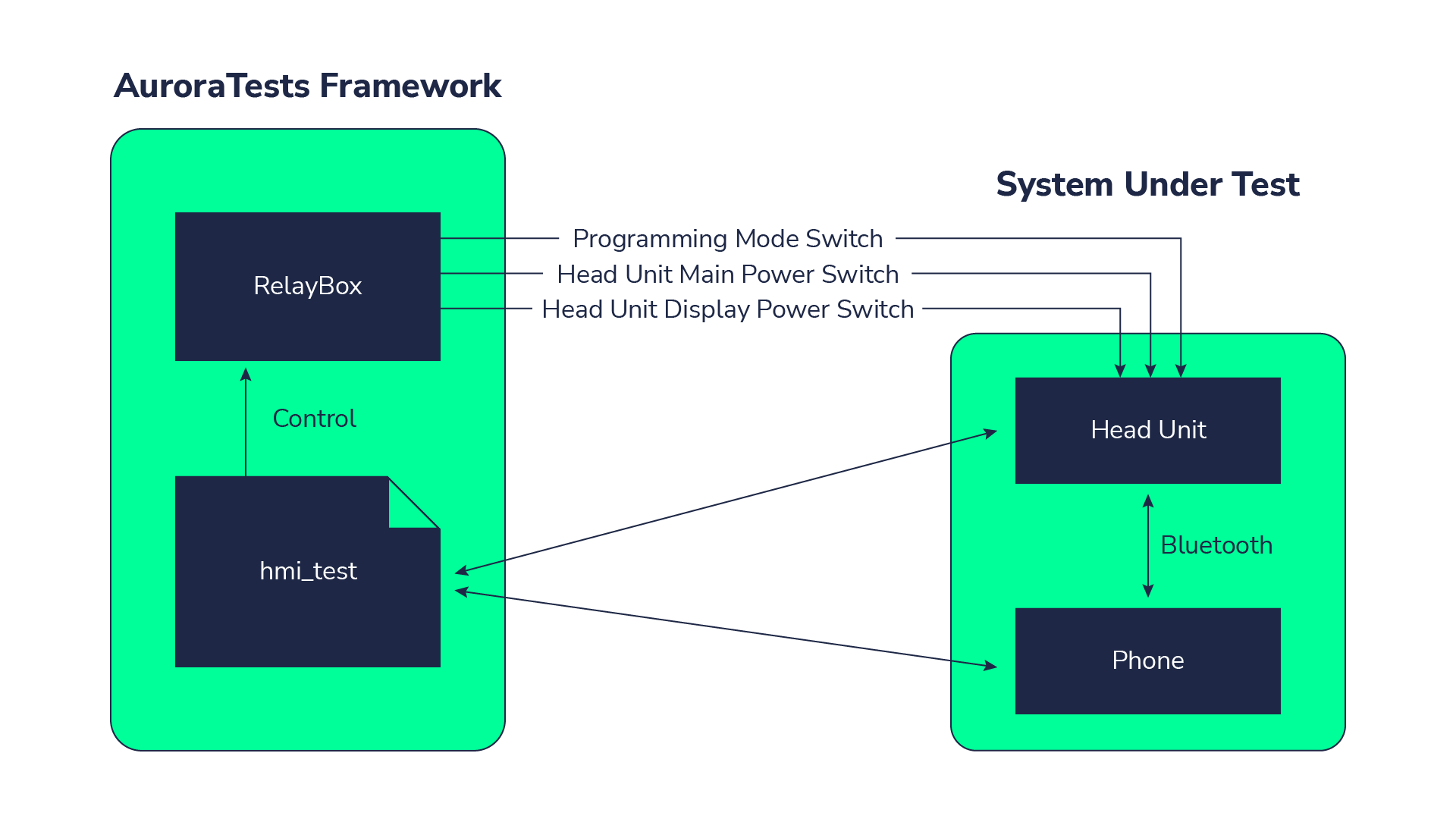Introduction to Automated Lifecycle Management
Imagine testing a complex infotainment system in an autonomous vehicle. Each time you need to simulate a power cycle, initiate a software update, or validate a display state, you have to manually reset the system, reconnect cables, or push hardware buttons. Now, multiply that by dozens of iterations during regression testing, and it’s easy to see how time-consuming and error-prone this can become. This is where HMI test automation and automated lifecycle management becomes a game-changer.
By automating power control and operational state transitions, you can eliminate manual steps, reduce human error, and ensure repeatable test conditions. In this post, we’ll walk you through how AuroraTests leverages hardware integration to enable fully automated lifecycle control of Head Units and similar systems in real-world HMI testing environments.
Expanding the Test Ecosystem with SUT Lifecycle Management
In our ongoing blog series on exploring AuroraTests’s capabilities, we’ve already explored various complex use cases for HMI testing. Now we expand the System Under Test (SUT) ecosystem by introducing one of the AuroraTests framework’s facilities features – SUT Lifecycle Management. This enables test engineers to dynamically control power states and operating modes from within their test scripts.
RelayBox Integration into the System Under Test
To effectively manage the SUT lifecycle, AuroraTests utilizes a hardware-based component known as the RelayBox, enabling seamless integration into your HMI test infrastructure. This device acts as a bridge between the software test environment and the hardware of the HMI system, allowing for automated control of power and signal lines.
By integrating a RelayBox into the SUT ecosystem, we enable precise control over the Head Unit’s lifecycle directly from an HMI test. This allows the test to dynamically manipulate power states and operating modes, ensuring fully automated lifecycle management without manual intervention.
Core Lifecycle Operations
Once integrated into the test setup, the RelayBox enables the following operations:
- Power Cycle the Head Unit: Automate on/off sequences to simulate system restarts or power failures.
- Display State Control: Switch the display on or off as part of test scenarios.
- Trigger Programming Mode: Seamlessly switch the Head Unit into flashing/programming mode for software updates.
The AuroraTests hardware tool arsenal includes several RelayBox options: 2-, 4- and 8-channel relays. They can be used in various combinations depending on the project’s specific needs and testing complexity.
Below is an actual example of the 4-channel RelayBox used for this case:
Test Scenarios: Automated Lifecycle Management in Action
To demonstrate the automated lifecycle management capabilities provided by the RelayBox in AuroraTests, we demonstrate two essential test scenarios:
Scenario #1: Head Unit Power Cycle
This scenario includes two test cases, focusing on powering the Head Unit and display on/off through automated control.
Test Case | Given | When | Then |
Power On | Head Unit and HU Display are powered off |
|
|
Power Off | Head Unit and HU Display are powered on |
|
|
Scenario #2: Head Unit Software Update
This scenario automates the process of updating the Head Unit software through the automated lifecycle management features.
Test Case | Given | When | Then |
Programming Mode | Head Unit and HU Display are powered off, and Programming Mode Switch is on |
|
|
Software Update | Head Unit is in Programming Mode |
|
|
Reset | The software update is finished |
|
|
RelayBox Configuration: Simplified Hardware Control
AuroraTests provides a flexible RelayBox configuration to control hardware components. A simple JSON-based setup maps relay names to their respective actions:
"Relays": [
{
"name": "Head Unit",
"alias_off": "Power Off",
"alias_on": "Power On",
...
},
{
"name": "HU Display",
"alias_off": "Off",
"alias_on": "On",
...
},
{
"name": "HU Prog Mode",
"alias_off": "Enable",
"alias_on": "Disable",
...
}
This configuration translates into an intuitive API, enabling effortless control from test scripts:
- relays.head_unit.power_on() – Powers on the Head Unit.
- relays.hu_display.off() – Turn the Display off.
- relays.hu_prog_mode.enable() – Enable Programming Mode for software update.
With this approach, AuroraTests makes hardware interaction straightforward and user-friendly, allowing you to focus on test logic rather than low-level hardware details.
Code Examples: Automating Lifecycle Test Cases
Building on the Test Scenarios, let’s examine how these lifecycle management capabilities can be implemented as automated test cases. Using the RelayBox and the AuroraTests framework, we can programmatically control the Head Unit (HU) and verify its behavior at each stage of the lifecycle.
Below, we provide implementations for the Power On and Power Off test cases, demonstrating how these scenarios are automated step by step.
Power On Test Case Code
def test_power_on(device_display, relays):
"""
Test Case: Verify the Head Unit powers on successfully.
Preconditions:
- Head Unit and its display are initially powered off.
- No display output is captured.
Steps:
1. Power on the Head Unit display and Head Unit.
2. Wait for the boot-up process to complete.
3. Verify that the display output becomes available after power-on.
"""
# Verify initial state: HU and its display are powered off
assert relays.hu_display.is_off(), "HU Display should initially be off."
assert relays.head_unit.is_power_off(), "Head Unit should initially be off."
assert device_display[DEV_HU].grab() is None, "No display content should be available when HU is off."
# Power on the HU display and Head Unit
relays.hu_display.on()
relays.head_unit.power_on()
# Wait for the Head Unit to boot up
time.sleep(BOOTUP_TIME_S)
# Verify final state: HU display should show content
assert device_display[DEV_HU].grab() is not None, "HU Display should show content after boot-up."
Power Off Test Case Code
def test_power_off(device_display, relays):
"""
Test Case: Verify the Head Unit powers off successfully.
Preconditions:
- Head Unit and its display are initially powered on.
- Display output is available.
Steps:
1. Power off the Head Unit display and Head Unit.
2. Wait for the shutdown process to complete.
3. Verify that the display output is no longer available after power-off.
"""
# Verify initial state: HU and its display are powered on
assert relays.hu_display.is_on(), "HU Display should initially be on."
assert relays.head_unit.is_power_on(), "Head Unit should initially be on."
assert device_display[DEV_HU].grab(
) is not None, "HU Display should show content when HU is powered on."
# Power off the HU display and Head Unit
relays.hu_display.off()
relays.head_unit.power_off()
# Wait for the Head Unit to shut down
time.sleep(SHUTDOWN_TIME_S)
# Verify final state: HU display should show no content
assert device_display[DEV_HU].grab(
) is None, "HU Display should not show content after shutdown."
For the complete implementation of these test cases, including the Head Unit Software Update scenario, you can explore the full source code in our GitHub repository.
Automated SUT Lifecycle Management with AuroraTests: One Framework, Many Applications
AuroraTests is not limited to HMI testing, it also supports full system control and simulation across embedded platforms and industrial environments.
We explored how AuroraTests enables automated lifecycle management of a System Under Test (SUT) by integrating hardware control directly into test scripts. Using a RelayBox or similar external control mechanisms, automated tests can reliably manage the power states and operational modes of the SUT, ensuring a fully controlled and repeatable test environment.
While this post focuses on Head Unit Power, Display Power, and Programming Mode as examples for lifecycle management, the same principles apply to various embedded systems, industrial devices, and other HMI-driven applications. By automating power control and mode switching, AuroraTests enables more robust and scalable validation workflows for a wide range of hardware-software systems.
Benefits of Lifecycle Automation in HMI Testing
Implementing automated lifecycle management in your test environment offers clear advantages:
✅ Full Lifecycle Control: The ability to power cycle the SUT, toggle specific components (e.g., displays, sensors, peripherals), and switch operational modes from an automated test script.
✅ Reliable and Repeatable Testing: Automated lifecycle management ensures that each test starts with a well-defined system state, eliminating inconsistencies caused by manual interactions.
✅ Software Update Automation: Transitioning the SUT into Programming Mode and performing updates programmatically helps streamline regression testing and deployment validation for example on CI/CD.
✅ Enhanced Debugging and Validation: Immediate assertions on system states, logs, and outputs improve test reliability and efficiency.
Start Automating Your Lifecycle Testing
If you’re ready to explore the full test implementations and how AuroraTests can handle lifecycle management for your specific hardware or project, reach out at info@datajob.se or schedule a demo to see AuroraTests in action.
Stay tuned for more insights on AuroraTests and discover how to elevate your HMI testing with comprehensive, automated control, both in software and hardware.






